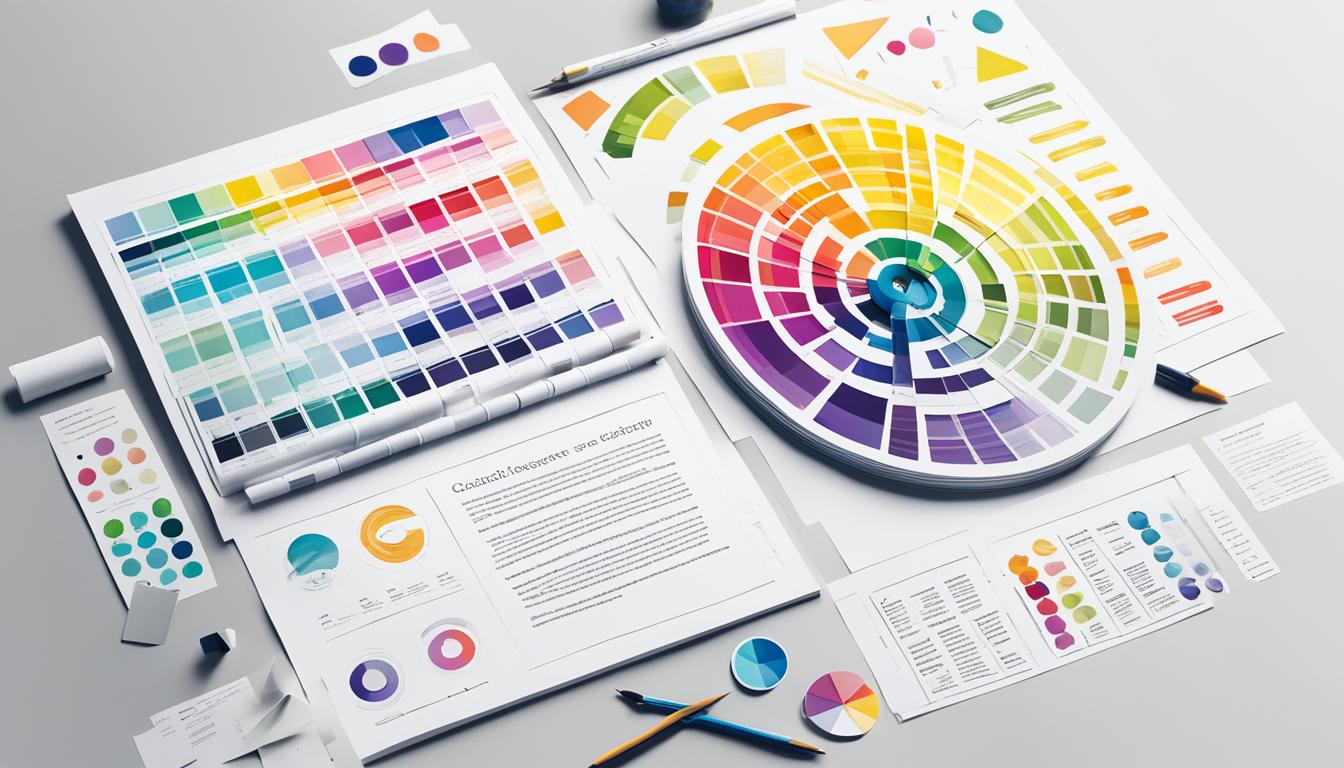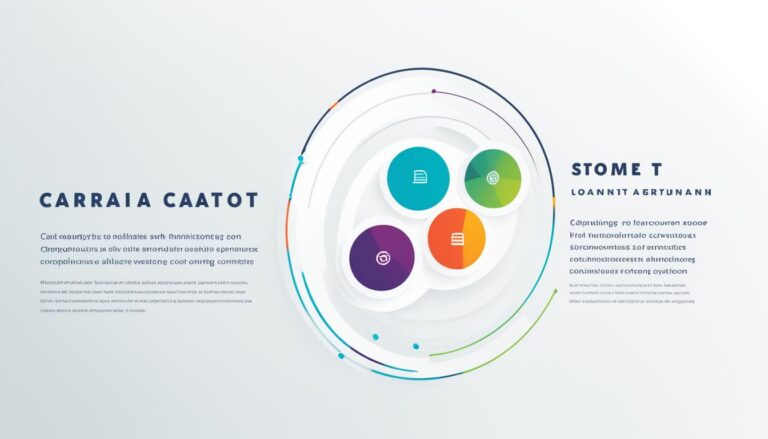Begin a Graphic Design Career: Essential Tips
Are you passionate about visual communication and creativity? Do you have an eye for aesthetics and a desire to learn how to bring ideas to life through design? If so, starting a career in graphic design might be the perfect path for you. In this article, we will provide you with valuable tips on how to start in graphic design, offer helpful advice for beginners, and guide you through the essential principles of graphic design.
Graphic design is a dynamic practice that combines visual elements, typography, and images to effectively communicate messages. Whether you want to create stunning prints, design engaging websites, or develop eye-catching digital content, it is crucial to learn and apply fundamental design principles. These principles, such as hierarchy, alignment, contrast, space, color, proximity, repetition, and balance, form the foundation of successful graphic design.
To kickstart your graphic design journey, it’s recommended to enroll in graphic design courses or explore online resources such as General Assembly, Vectornator Academy, Skillshare, LinkedIn Learning, Udemy, and Coursera. These platforms provide comprehensive lessons taught by industry professionals and can help you develop a deeper understanding of design principles and techniques.
In addition to theoretical knowledge, mastering design programs is imperative in the graphic design field. Programs like Adobe Illustrator, Adobe InDesign, Adobe Photoshop, and Sketch are widely used by professionals and offer powerful tools to create professional designs. Taking the time to familiarize yourself with these programs and their functionalities will greatly enhance your graphic design skills.
Building a strong network within the graphic design community is also essential for growth and skill development. Engaging with fellow designers, following design influencers, and attending design events can provide valuable insights, inspiration, and potential collaboration opportunities. By regularly practicing, building an inspiration catalog, and emulating designs from professionals, you can continue to refine your skills and expand your creative horizon.
Embarking on a career in graphic design requires dedication, continuous learning, and a passion for visual storytelling. By following these essential tips, you will be well on your way to starting a successful journey in the captivating world of graphic design.
The Importance of Passion and Learning Design Principles
Passion is a driving force in the graphic design journey, igniting creativity and motivation. Cultivating a graphic design passion requires active engagement in design-related activities and exploration of different styles and mediums. By immersing oneself in the world of design, aspiring graphic designers can discover their unique creative voice and develop a strong foundation for their career.
However, passion alone is not enough to succeed in the realm of graphic design. It is equally important to understand and apply design principles that form the backbone of visually captivating and effective designs. Design principles such as hierarchy, alignment, contrast, space, color, proximity, repetition, and balance are essential for creating compelling visual compositions.
Implementing these principles ensures that designs are cohesive, impactful, and visually pleasing. Hierarchy determines the order in which elements are presented, guiding the viewer’s attention and conveying information effectively. Alignment creates visual harmony and establishes a clear structure, enhancing the overall readability and professionalism of designs. Contrast adds visual interest, emphasizing important elements and creating a dynamic visual experience. Space allows for a sense of breathing room and visual balance, preventing designs from looking cluttered. Color choices play a significant role in conveying mood, evoking emotions, and establishing a strong visual identity. Proximity groups related elements together, facilitating comprehension and establishing visual relationships. Repetition creates consistency and visual rhythm throughout designs. Balance ensures that elements are distributed evenly, creating a sense of stability and harmony.
Understanding typography and color theory is also crucial for effective visual communication. Typography not only encompasses font selection, but also encompasses considerations such as font size, line spacing, and typography hierarchy. Color theory involves the study of color harmonies and how different color combinations evoke different emotions and create visual impact.
Developing a Passion for Graphic Design
Developing a graphic design passion involves active participation in design-related activities and continuous exploration. Here are some strategies to foster a strong passion for graphic design:
- Immerse yourself in design inspiration by following influential designers and design studios on platforms like Behance and Dribbble.
- Create a design inspiration catalog or mood board to collect visual references and ideas that resonate with your design aesthetic.
- Experiment with different design styles and mediums to broaden your creative horizons and discover your unique artistic voice.
- Engage in design challenges and competitions to push your creative boundaries and gain exposure.
- Attend design conferences, workshops, and webinars to connect with fellow designers and gain insights from industry professionals.
Learning and Applying Design Principles
To effectively apply design principles, it is essential to engage in structured learning and practical application. Consider the following steps to enhance your understanding and implementation of design principles:
- Enroll in graphic design courses or online tutorials that cover the fundamentals of design principles and their application in real-world scenarios.
- Utilize design software such as Adobe Illustrator, Adobe InDesign, Adobe Photoshop, or Sketch to practice and experiment with design principles.
- Seek constructive feedback from experienced designers or mentors to refine your understanding and execution of design principles.
By combining passion with a solid foundation in design principles, aspiring graphic designers are better equipped to create visually compelling and impactful designs that effectively communicate messages to their intended audience.
Building Skills and Expanding Knowledge
Building skills in graphic design is essential for aspiring designers looking to excel in their careers. By enrolling in graphic design courses and mastering design programs, individuals can gain a solid foundation and create professional designs. Additionally, networking with fellow designers and practicing regularly helps to improve skills and expand knowledge in the field.
Graphic Design Courses and Master Design Programs
Taking graphic design courses is a great way to learn the fundamentals of the discipline and gain a deeper understanding of design principles. Online resources like General Assembly, Vectornator Academy, Skillshare, LinkedIn Learning, Udemy, and Coursera offer a wide range of courses to choose from, catering to different skill levels and areas of interest. These courses cover topics such as the history of graphic design, design subdivisions, psychology, and the essential tools of the trade.
Mastering Design Programs
Mastering design programs like Adobe Illustrator, Adobe InDesign, Adobe Photoshop, and Sketch is crucial for creating professional designs. These programs allow designers to bring their creative visions to life and work efficiently. By familiarizing themselves with the features and capabilities of these design tools, aspiring graphic designers can enhance their skills and produce high-quality work.
Networking with Designers
Networking with fellow designers is a valuable way to gain insights, exchange ideas, and establish professional connections within the industry. Social networking platforms like Facebook and LinkedIn offer opportunities to join design groups, engage in discussions, and collaborate with other designers. Attending meetups and participating in design events also provides a chance to meet industry professionals, learn from their experiences, and seek guidance.
Practice Makes Perfect
Regular practice is essential for honing graphic design skills and gaining hands-on experience. Design exercises and design prompts help to sharpen creativity, problem-solving abilities, and technical skills. By regularly practicing graphic design, aspiring designers can push the boundaries of their abilities, discover their design style, and build a strong portfolio.
“Design is not just what it looks like and feels like. Design is how it works.” – Steve Jobs
Emulating and analyzing designs from professionals is also a valuable exercise in expanding knowledge and developing a critical eye. By studying successful designs, designers can gain insights into effective visual communication, layout techniques, and design trends.
| Benefits of Building Skills and Expanding Knowledge | How to Achieve Them |
|---|---|
| Better job prospects | Enroll in graphic design courses and master design programs |
| Enhanced creativity | Network with designers and practice graphic design regularly |
| Increased industry recognition | Analyze designs from professionals and learn from their techniques |
| Greater design versatility | Regularly practice and explore different design styles and mediums |
Conclusion
Starting a career in graphic design requires a combination of passion, dedication, and continuous learning. By mastering design principles, aspiring graphic designers can create impactful designs that effectively communicate messages. It is crucial to enroll in graphic design courses and practice regularly to develop and refine skills. Building an inspiration catalog, networking with fellow designers, and seeking constructive feedback are also essential for growth and improvement.
Embracing challenges and passion projects allows aspiring graphic designers to push their boundaries and explore new creative possibilities. Additionally, seeking opportunities for real-world experience, whether in-house, agency, or freelance, provides invaluable practical knowledge and industry exposure. With the right mindset, tools, and knowledge, individuals can embark on a successful graphic design career in today’s diverse and ever-evolving industry.
So, take those first steps, follow these tips to start in graphic design, and seize the numerous opportunities this field offers. Remember to stay curious, stay creative, and keep honing your skills as you pursue your graphic design career.
FAQ
How do I start a career in graphic design?
To start a career in graphic design, it is important to learn and apply fundamental design principles like hierarchy, alignment, contrast, space, color, proximity, repetition, and balance. Enrolling in a graphic design course or using online resources can help improve skills and gain a deeper understanding of design.
What are some online resources for learning graphic design?
Some online resources for learning graphic design include General Assembly, Vectornator Academy, Skillshare, LinkedIn Learning, Udemy, and Coursera. These platforms offer a range of courses to choose from, covering various aspects of graphic design.
Which design programs should I master?
It is essential to master design programs like Adobe Illustrator, Adobe InDesign, Adobe Photoshop, and Sketch. These programs are widely used in the industry and will help you create professional designs.
How can networking benefit my graphic design career?
Networking with fellow designers can provide valuable insights, guidance, and potential job opportunities. Social networks like Facebook and LinkedIn, attending meetups, and participating in design events are great ways to connect with other professionals in the field.
How can I improve my graphic design skills?
Regular practice is key to improving graphic design skills. Using design exercises and prompts, emulating and analyzing designs from professionals, and seeking constructive feedback are all effective ways to enhance your understanding and creativity.
What are some tips for aspiring graphic designers?
Aspiring graphic designers should embrace challenges and passion projects, while also exploring opportunities for real-world experience. Building an inspiration catalog, networking with fellow designers, and constantly seeking growth and improvement are essential for a successful career in graphic design.










